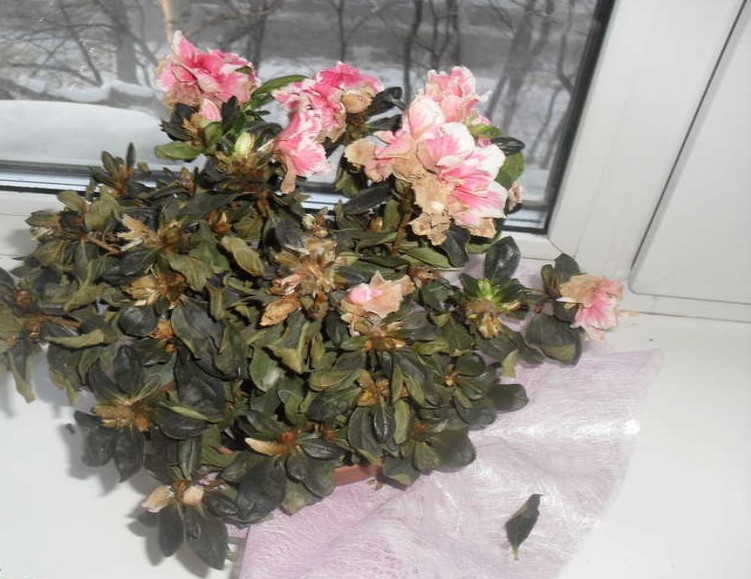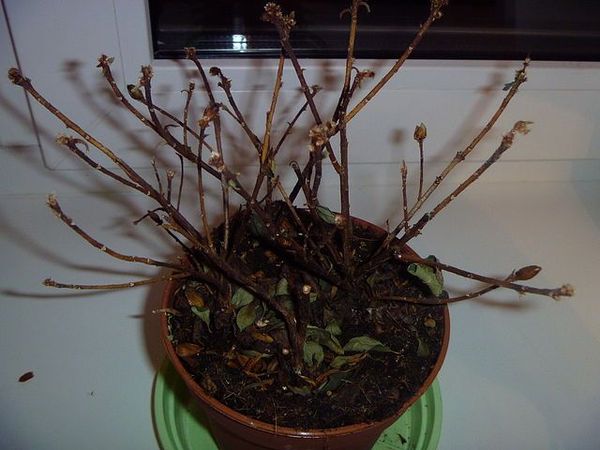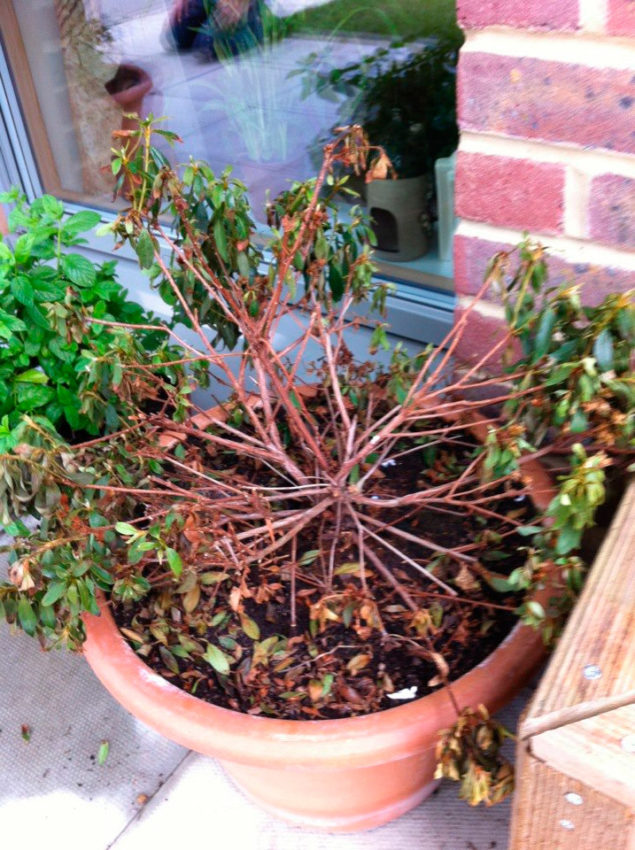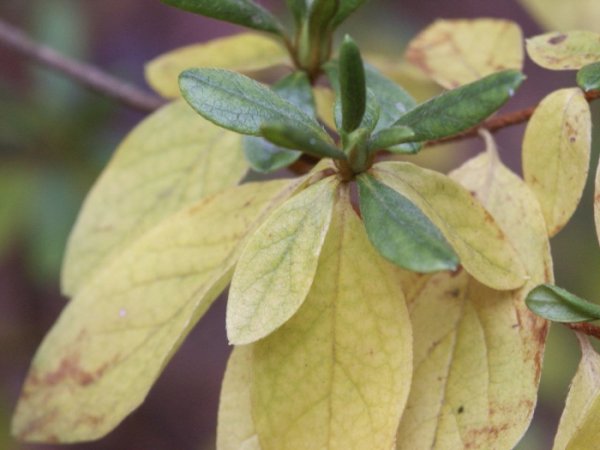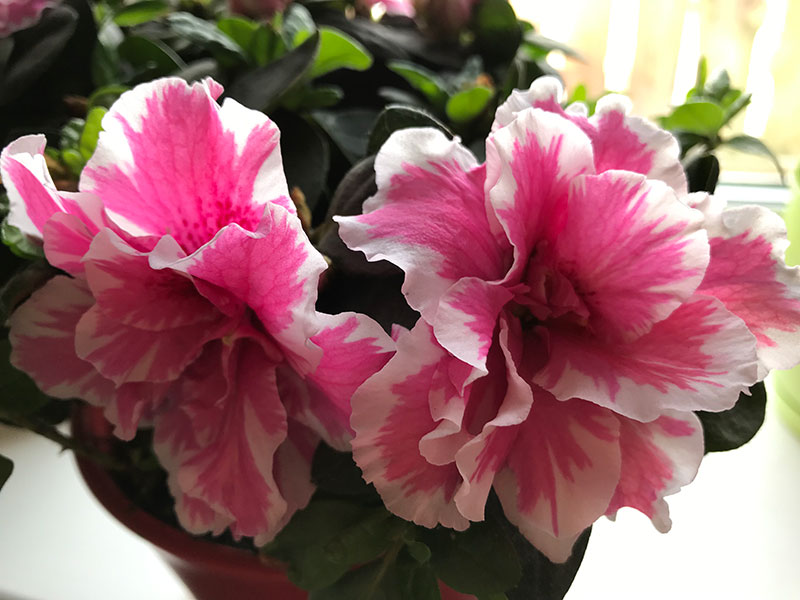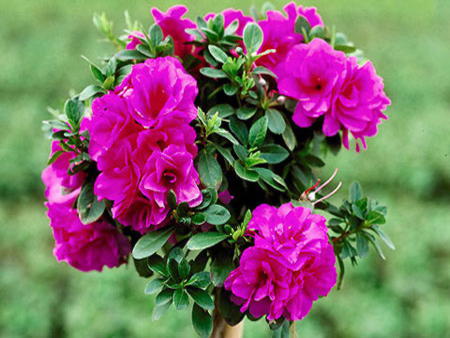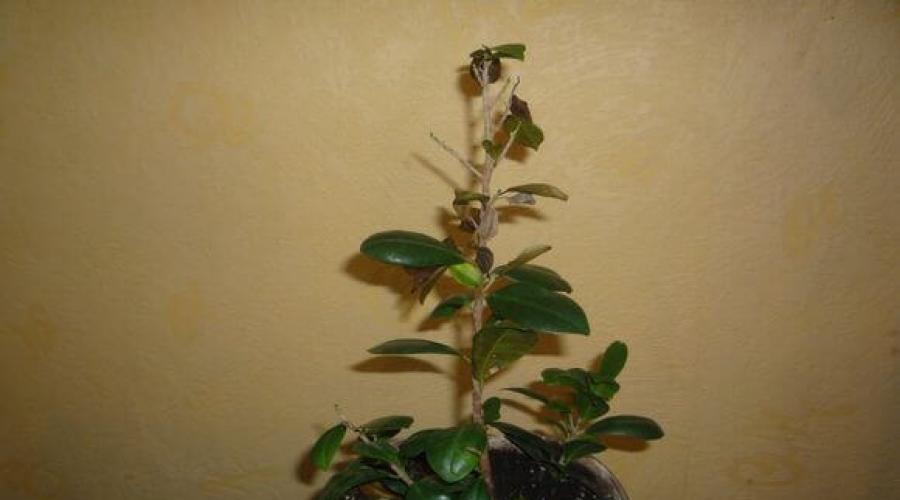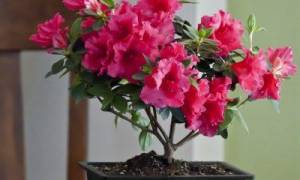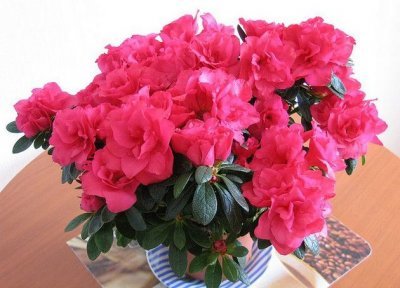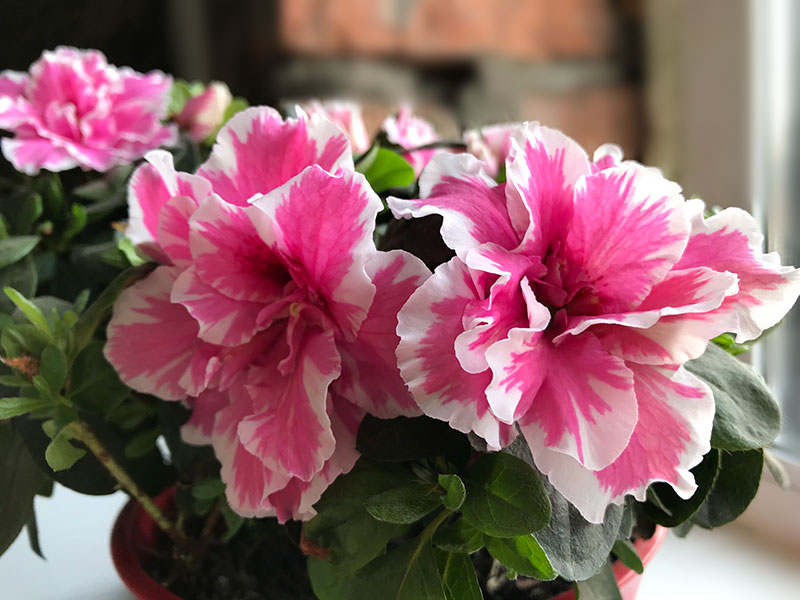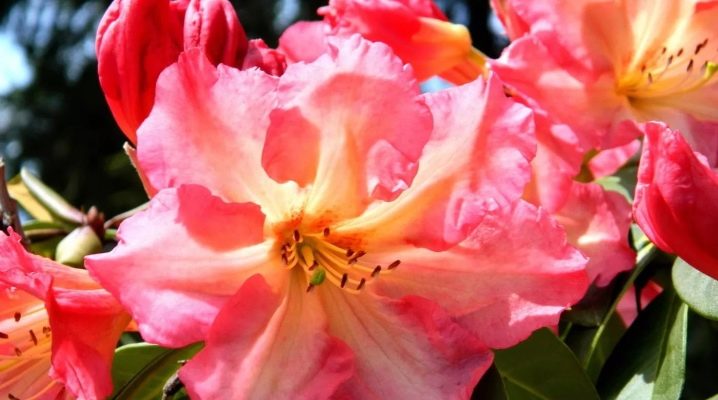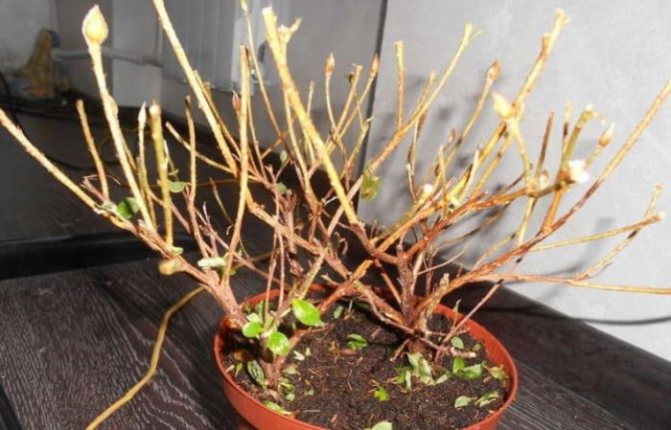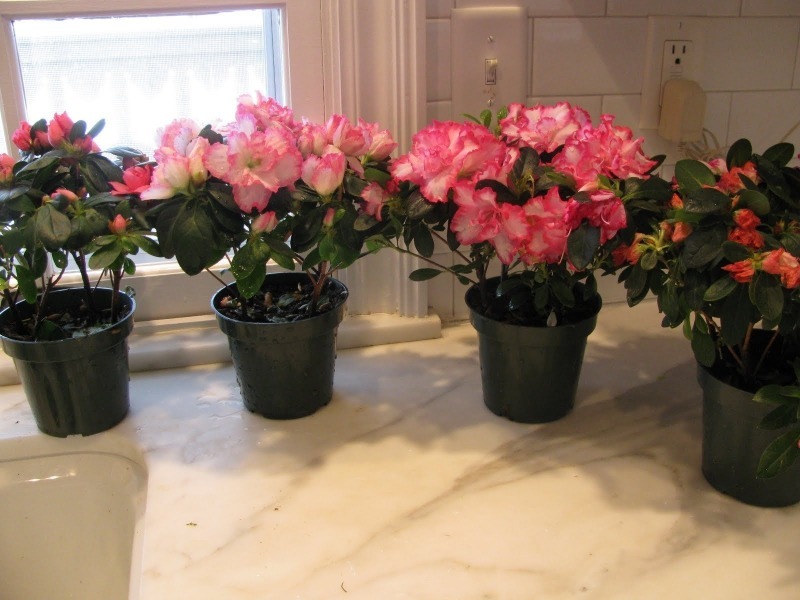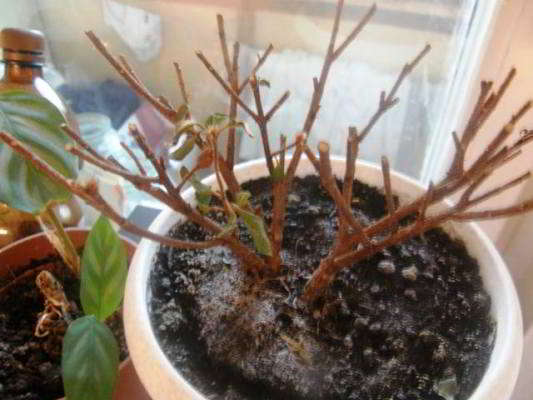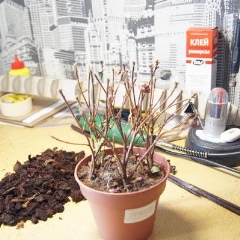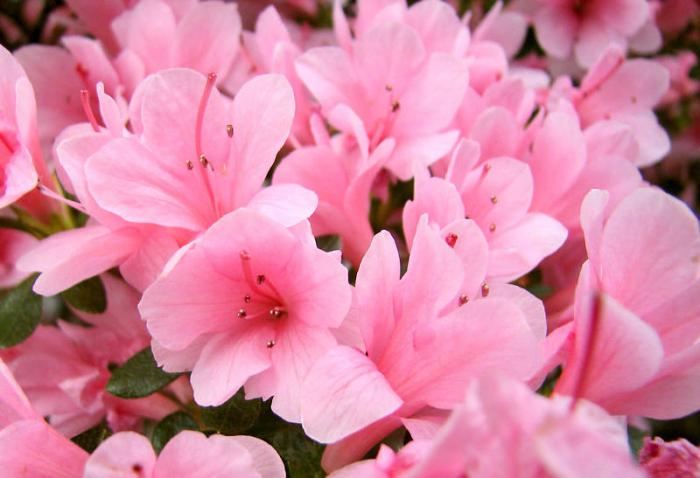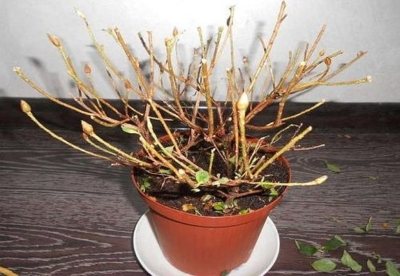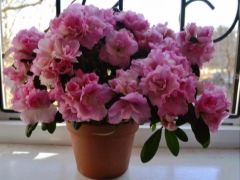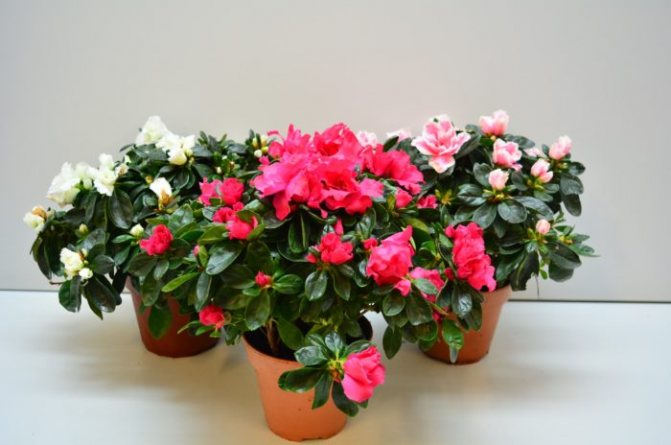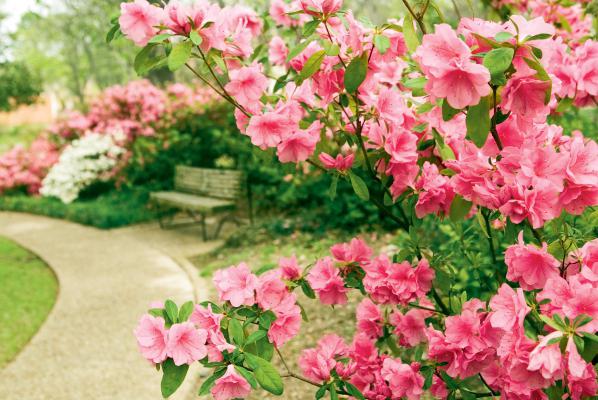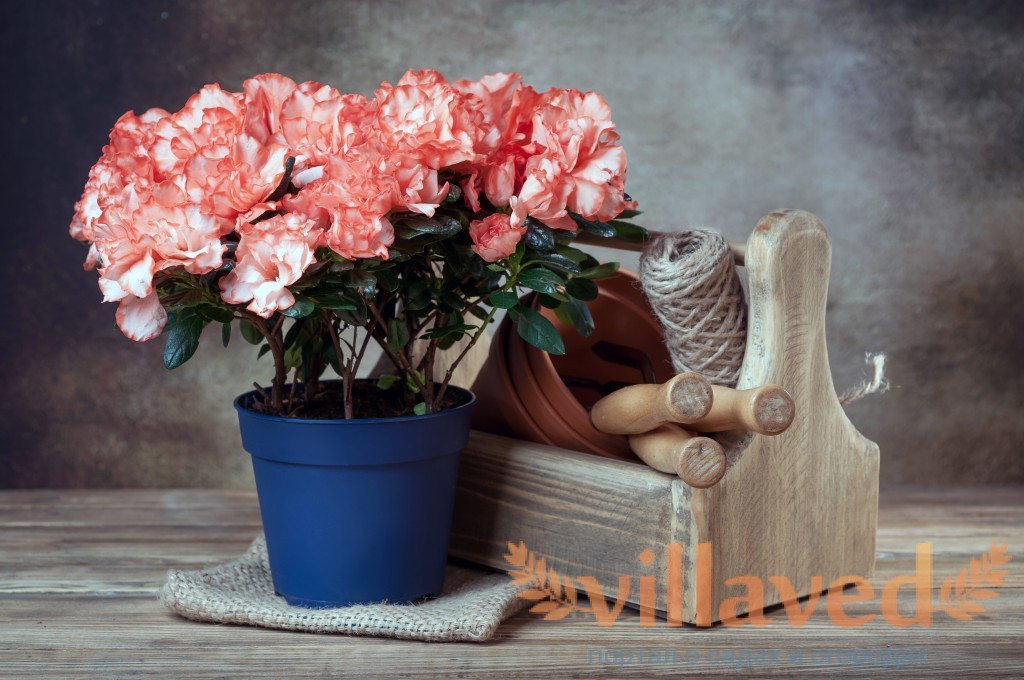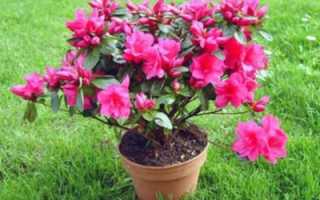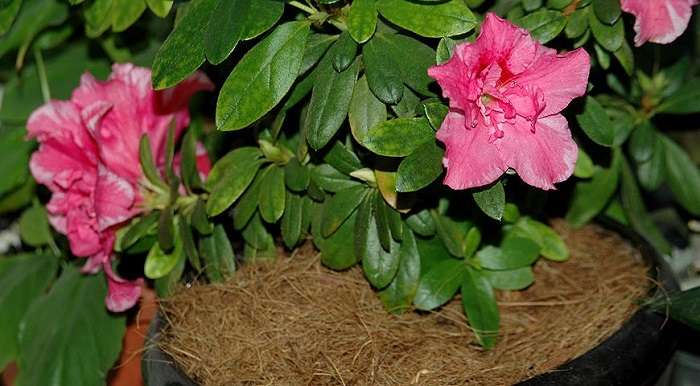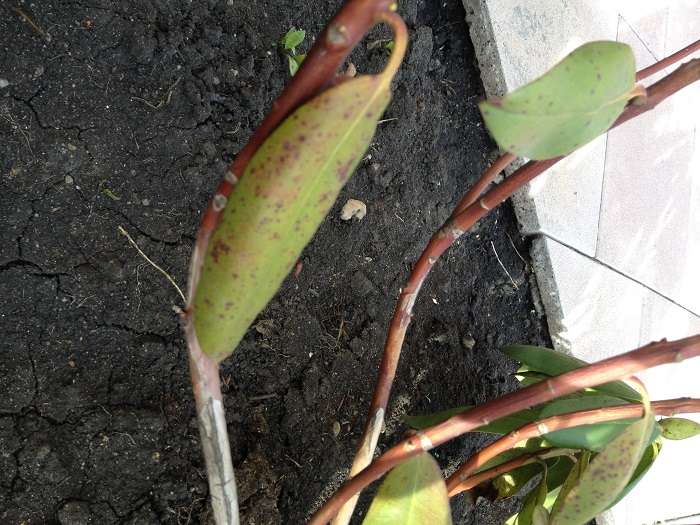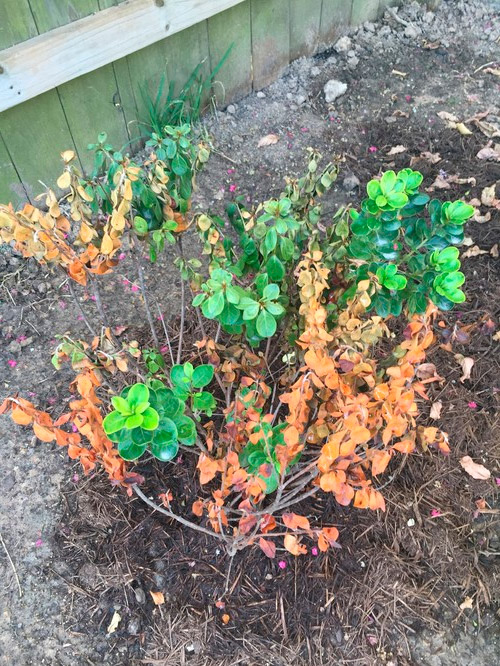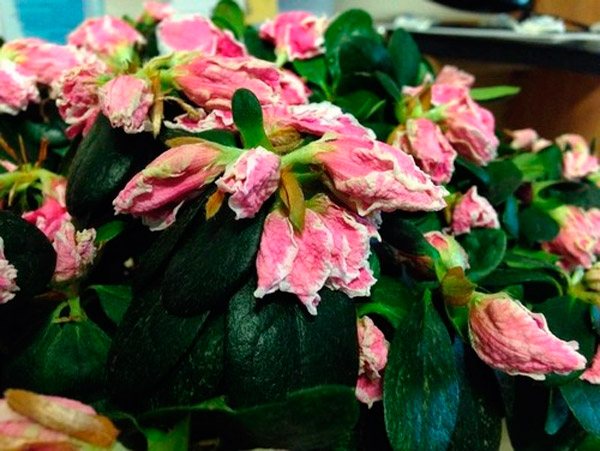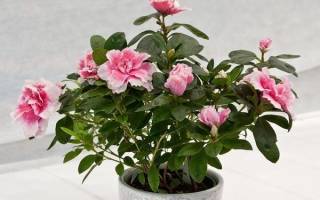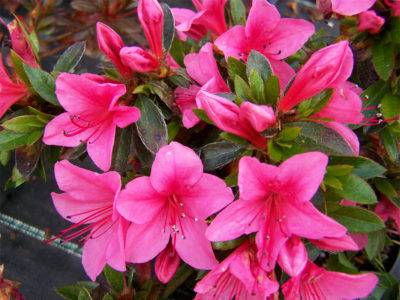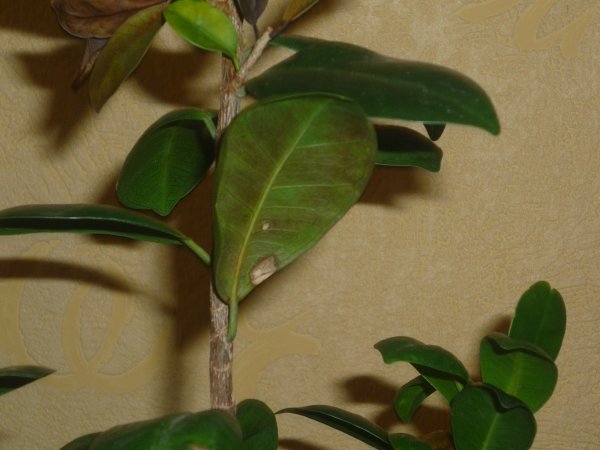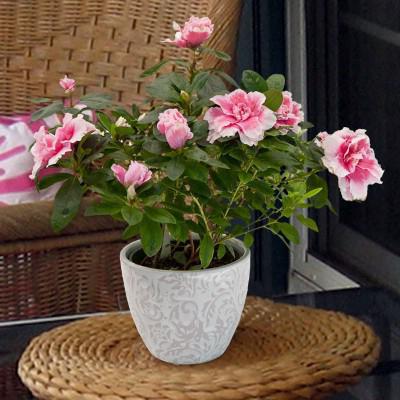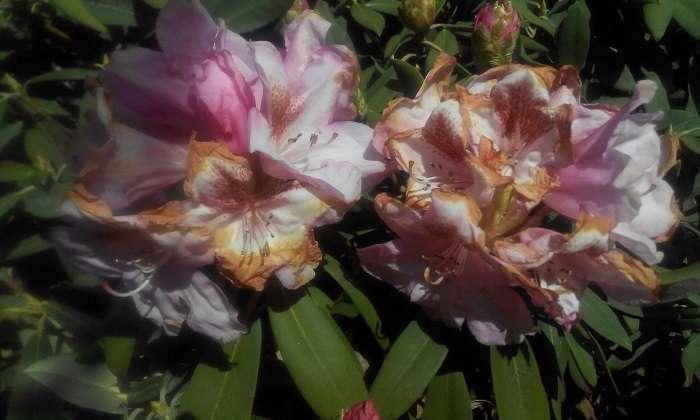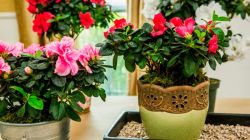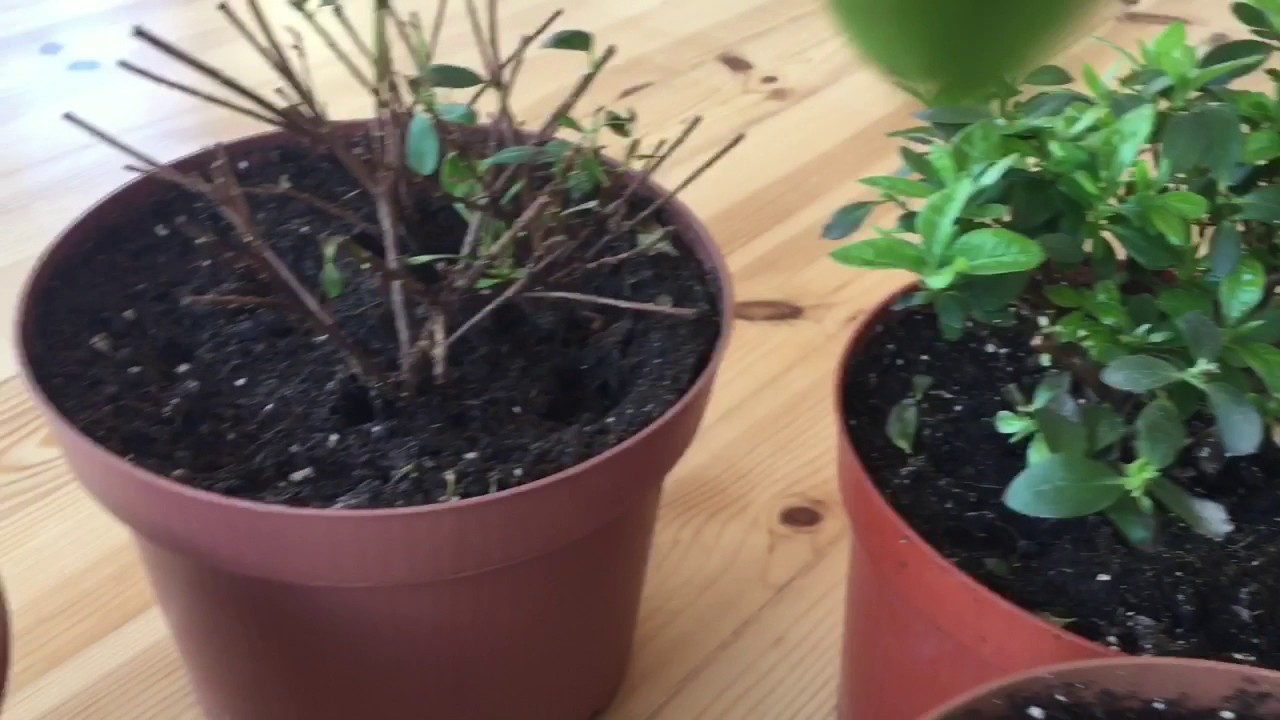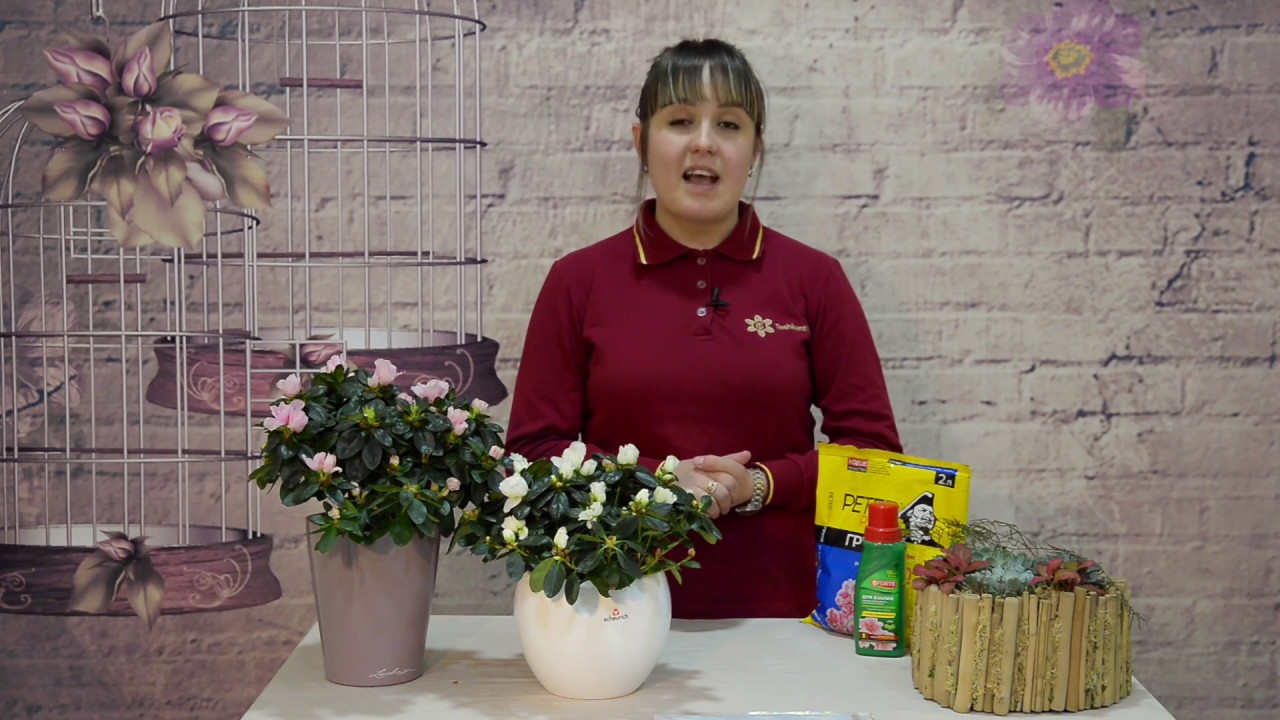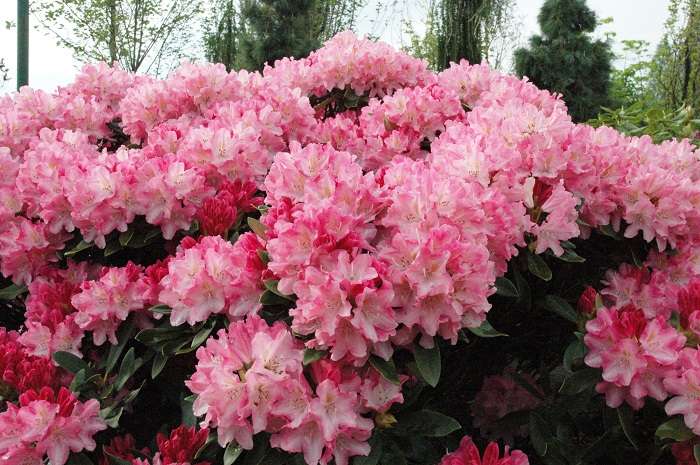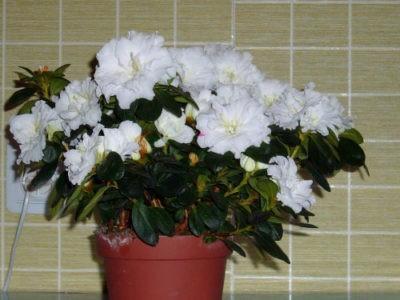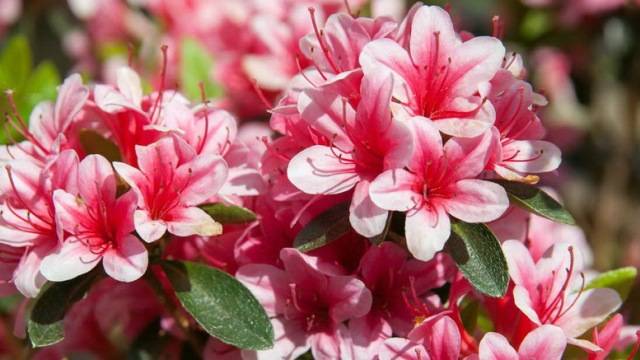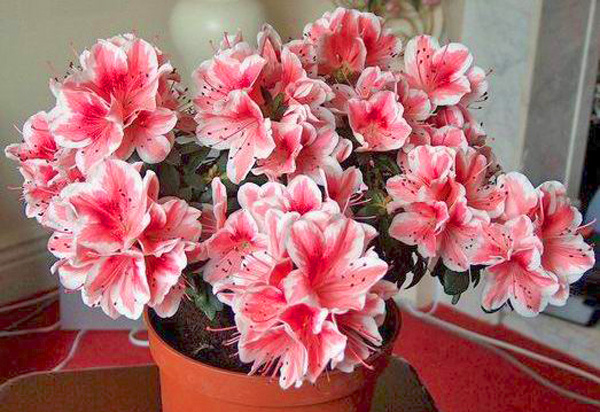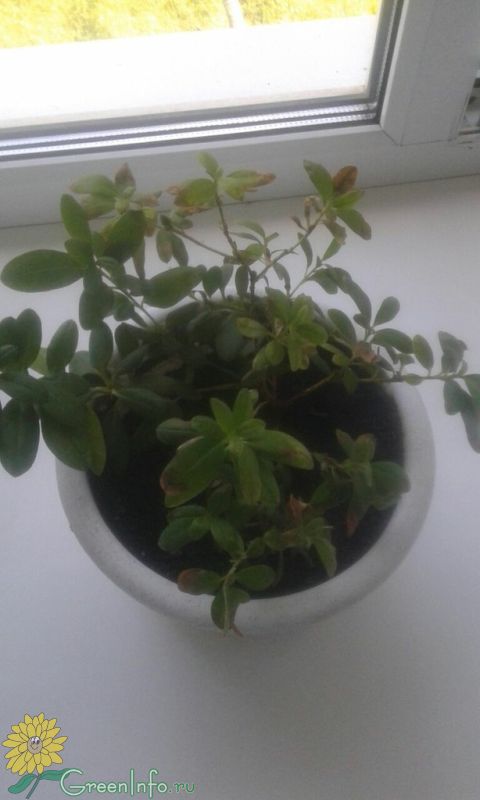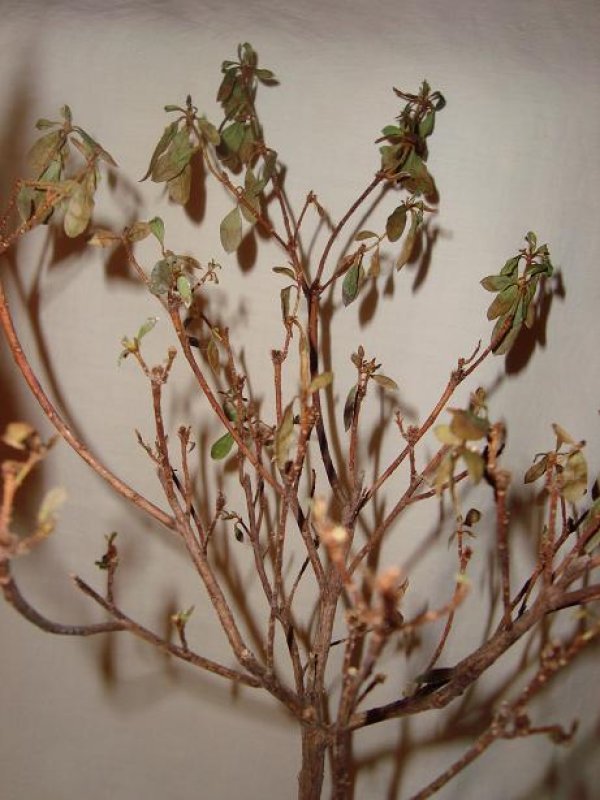What is houseplant drying?
Drying is a phenomenon when more water evaporates from the leaves of plants than enters them from the soil and air. Azalea is a very demanding flower for the environment. She does not tolerate heat, she will be much more comfortable in a cool place. The optimum temperature is from 12 to 18 degrees. Also, the flower has an intolerance to direct sunlight. At the same time, she will not be able to survive in a dark place.
It is important! You cannot expose the azalea to a stressful situation during transportation and buy it in winter: it will freeze and not one or two layers of kraft paper will save the plant.
Appearance
In drought conditions, the appearance of the azalea may change even before the active phase begins.
Drought signs:
- the appearance of dry grayish spots;
- invasion of pests (read about pests and diseases of azaleas here);
- the appearance of brown or brown spots;
- the tips of the leaves dry up and turn brown;
- falling leaves.
What is the danger for rhododendron?
Azalea is a very delicate flower and may simply not tolerate drying. It cannot be left to grow in a small pot for a long time. After the end of flowering, it must be transplanted using the transshipment method.
Lack of attention to environmental conditions, pot size and soil composition can be hazardous to the plant. Draft and frequent temperature changes will turn brown and dry leaves for the plant. Another reason for the formation of brown tips on the leaves is using too hard water for watering. Or the plant is overdried.
How not to harm a houseplant?
Today, there are many varieties of flowering indoor plants from the genus Rhododendrons on sale (in floriculture they continue to separate azaleas from other representatives of rhododendrons).
All modern varieties of this domestic beauty descended from two species: the Sims azalea and the Japanese azalea.
Hybrids have a different shape, size and color of buds - from snow-white to rich coral and dark lilac. Among them there are varieties bred by our breeders. This is, for example, the indoor beauty Cinderella, which has not very large multi-layered flowers of a delicate lilac color.
Indoor shrub from the genus rhododendron is quite capricious and requires special attention to itself.
Despite the fact that all varieties of indoor shrubs are bred by selective, artificial means, when caring for it, one should take into account the peculiarities of the life of this plant in the wild. Caring for him is based on this.
Light and temperature
In nature, rhododendrons love to hide in the partial shade of other plants. After all, they grow in mountain forests.
Household varieties also dislike direct sunlight. Therefore, you need to place shrub pots in several shaded areas.
If the indoor shrub is constantly on the southern windowsill, yellow or just dry spots may appear on the leaves. These are sunburns.
In general, azalea is very sensitive to temperature conditions. In summer, the air should be 20 - 22 ◦С, and in winter - no higher than 15 ◦С. Therefore, there is definitely no place for it on the windowsill above the radiators. Because of this, buds and leaves can dry out and fall off.
Air humidity and watering
Since plants of this genus come from the mountainous regions of India and China with a humid climate, rhododendron plants also like high humidity air at home. They are great for spraying and even warm rain in the garden or on the balcony.
The flower should be sprayed 1 - 2 times a day. But, when it blooms, spraying is stopped, since delicate buds, without blooming, can fall off.
At the same time, the plant does not tolerate overflow, stagnant water. Because of this, the leaves may be covered with brown spots or blackened around the edges. In addition, due to stagnant water, the thin roots of the plant can rot. This will lead to the death of the bush.
Do not water it with water directly from the tap. Better to use rainwater, river water. But it should be at room temperature.
This is one of the few indoor plants that prefers acidic soil - a mixture of peat and coniferous humus.
Further care
The main components of proper care:
- diffused light;
- abundant infrequent watering;
- loosening the soil;
- compliance with the acidity level of the soil;
- low air temperature in a room with an azalea.
Sufficient air humidity for this plant is 80%.
It is better to apply complex fertilizing in the spring. For these purposes, special fertilizers are suitable:
- to stimulate the formation of inflorescences, formulations with phosphorus and potassium are introduced;
- for the growth of shoots - nitrogen compounds.
It is better to prune the bushes in May. Old or strongly elongated shoots are subject to pruning. 14-20 days after pruning, the bush is covered with new leaves.
We watch a video about the proper care of azalea.
So, azalea is a whimsical and capricious flower. Violation of care leads to the appearance of dangerous symptoms and conditions. It is necessary to revive or save the plant in case of massive yellowing, wilting, dying off of leaves and other organs. The measures and methods of revitalization depend on the exact cause of the phenomenon.
Azalea withered, how to save? Azalea care features Azalea is a very beautiful and unusual plant. But at the same time, and quite gentle, demanding care. That is why the plant is very often prone to various diseases and troubles, including the azalea can dry out or lose all its leaves. Features of the plant Azalea (rhododendron) is an ornamental shrub that can decorate a home with its flowering at any time of the year.
How to reanimate after illness
Azalea diseases are the result of care errors. They can be caused by changes in air temperature and humidity levels. If azalea leaves turn black, then the cause may be the Black Triassic or infection with fungal diseases. Septoria (red-yellow spots with black dots), cercosporiasis (brown spots with red edges with the bottom side of the sheet), phyllostictosis (brown or gray spots) are characterized by the presence of spots that appear and grow on the leaves and stems of the plant. Late blight affects the roots, and it indicates the twisting and drying of the leaves, which first darken, starting from the very tips, change color, and then curl and fall off.
Special drugs that need to be used as early as possible will not allow these diseases to progress: Bordeaux liquid, "Fundazol", "Ditan", "Topsin-M" or other fungicides. With verticillosis, the base of the stem darkens, and not the leaf, it can rather lead to death. Timely treatment with copper sulfate or fungicides will save you. The sooner the disease is established, the sooner the treatment will begin, which means there will be more hope for the complete recovery of the plant.
After using special preparations, it is necessary to destroy all affected parts of the plant in order not to give the disease a chance to return. An azalea that has undergone illness needs recovery procedures no less than after an invasion of pests or drying out due to poor care. The main goals are the same: restore immunity, improve conditions, and help absorb nutrients.
Azalea is certainly transplanted into new soil, be sure to check the condition of the roots. Then apply frequent watering and spraying with water with boric and citric acid alternately, sometimes using Elina solution to enhance immunity.
Video: TEST: a recipe for how to revive dried mascara, does it work or not?
When the azalea is sick, it always hurts the heart.This is such a beautiful flower that I do not understand now the time when I did not even have the slightest thought to have it at home. It has become more beautiful and more pleasant with her, and when she blooms, I cannot convey to you in words how beautiful this phenomenon is.
I have encountered problems such as completely falling leaves after the azalea was brought home from the store. In principle, you can understand - the plant sheds its leaves, because to some extent the conditions of the plant have changed. In stores, they often use some kind of special plant support system, so it can adapt for a long time to home, natural conditions. As far as I know, in this case, it is advised to prune dry twigs on which there are no more leaves, or light pruning of active and live twigs, but which have also shed their leaves.
What leads to azalea diseases
In the case when
at
azaleas
fold up first, and then
dry
leaves
, which means that the problem lies in the defeat of the bush by moths. You won't have to look for her for a long time. It looks like a spindle-shaped caterpillar. The sequence of actions to combat it is quite simple - collecting the moth and treating the plant with a chemical (issecticide).
Azalea also dries up due to a long-standing defeat by the rhododendron bug.
It was probably overlooked a little earlier that discolored spots appeared on the leaves by a rhododendron bug, which itself is 03, -0.4 cm long. Eggs are laid on the underside of the leaves. The overwintered new generation hatches in the tissues of the plant and continues to actively damage the bush. To rescue
azalea
can be diazinon.
If beloved
azalea shedding leaves
, but not as described in the previous cases,
what to do
any experienced florist knows. In the case when the plant has fusarium, the whole process is accompanied by a number of other signs. Among them, the change in the appearance of the foliage, its paleness, then yellowing, twisting and wilting, stands out separately. The kidneys turn brown and die. Fusarium first appears
in a pot
, at the roots. The reason is too humid environment and a significant excess of the required thermal regime.
Rescue treatments:
- antibiotics;
- fungicides;
-
copper sulfate,
followed by processing with potassium permanganate after 14 days.
Noticing that
«
potty beauty
»
turned black
in the form of irregular angular brown spots with a red canvas on the bottom of the foliage, one can guess that the plant has cercospora. At the same time, a gray bloom is noticeable on top of the foliage.
If spots of ash-gray and brown color appeared on top of the edges, it means that the plant got sick with phyllostictosis.
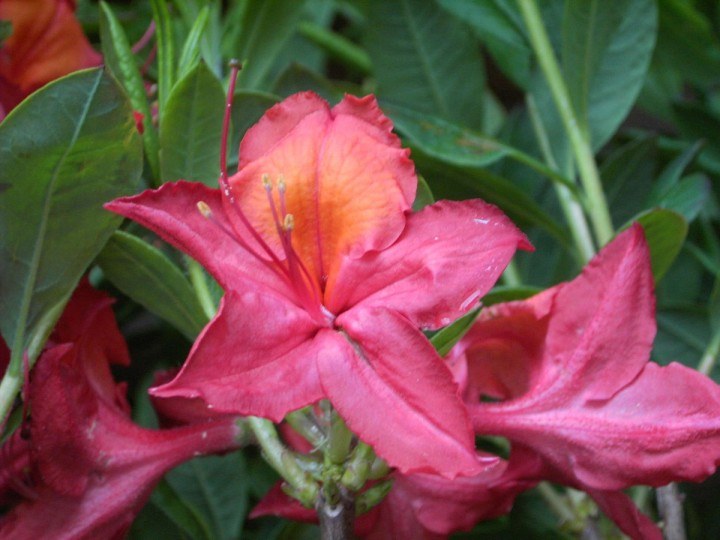 In both cases, you should resort to the use of fungicides, as well as reducing moisture, including reducing the number of watering and spraying.
In both cases, you should resort to the use of fungicides, as well as reducing moisture, including reducing the number of watering and spraying.
Throwing off the leaves, the bush informs the owners of the problems. Accompanying signs indicate which ones.
If "fussy"
threw off
greens, it means that she is not satisfied with the level of care, and she decided to cheer. The "capricious lady" from the world of flora is worth courting. And then, in return, she will delight with her beauty.
When
azalea shedding leaves
,
why
it should be known in all variants, as well as how to understand and follow all the conditions for caring for this plant. Periodic examination, removal of damaged areas, timely treatment prevent her death.
Everything you need to know about when and why
the azalea dries
, set out in this article. This plant only feels comfortable if it receives a lot of attention. And compliance with all care requirements will be expressed by the abundant flowering of the bush.
Azalea occupies its niche in the garden classification. This is a plant of a separate variety, belonging to the rhododendrons.It has many varieties, but there are certain parameters that are characteristic of all plants: height from 30 centimeters to three meters, colors of different shades: red, blue, white, pink. Azalea looks attractive both in the summer cottage and on the windowsill. Its varieties are divided into deciduous and evergreen. The last variety is referred to as "Japanese", they bloom on May days, reveal themselves in full beauty. Deciduous ones bloom in June, and the leaves are shed in autumn. Many are embarrassed that azalea can lose foliage, inexperienced gardeners worry that the plant is sick. We will deal with cases when indoor azalea sheds leaves for natural reasons, and when they turn brown and dry out due to illness, we will show a photo and tell you what to do for treatment and care at home.
How to save an azalea
Before proceeding with the restoration - resuscitation, it is necessary to make sure that the rhododendron has not completely wilted and that it still has living buds and shoots. Compliance with the basic recommendations for saving a potted culture gives a chance for its revival.
Sequence of resuscitation actions
To reanimate the azalea, it is necessary to perform a number of sequential actions:
- First, the shrub should be removed from the container and identified in a bowl of cool water.
- After that, it is necessary to free the azalea roots from excess soil substrate, trying to injure them as little as possible.
- Then the roots are washed and areas affected by rot are removed.
- For faster and more effective recovery, the azalea is immersed in a container with a biological product solution for 30 minutes.
- Before transplanting into new land near the shrub, dry and wilted leaves should be cut off.
In the future, the frequency of watering should be 2 times a week using exclusively settled water. Thanks to such actions, it is possible to save the azalea bushes from death.
Transplant rules
This bright representative of rhododendrons needs an annual transplant. It is recommended to increase the size of the container each time. For azaleas, it is preferable to transfer to the substrate using acidic deciduous soil, peat, sand, needles and wood ash (activated carbon). You can also add a growth promoter for better shoot formation.
In order to avoid stagnation of moisture in the pot, a drainage pillow made of expanded clay should be laid on the bottom. In the first 12 hours after transfer to another container, irrigation is carried out in a moderate dosage. On the second day, the flower pot should be covered with ice cubes and moistened. The main thing when transplanting is not to damage the root system of the azalea, otherwise it will hurt for a long time and poorly recover. For young plants, the transshipment frequency is every year (up to three years), and for adult specimens - once every 2-3 years.

Recovery after transplant
To revive the azalea and help it recover, you need to provide it with comfortable conditions of detention. It is recommended to place a flower pot in a darkened part of the room; for irrigation, use a working solution based on boric acid or lemon juice (5 drops of the product per 1 liter of water). This liquid is used during the entire recovery period. It is effective at this stage to carry out feeding procedures - once a week with a growth stimulator of the Zircon type at the rate of 2-3 drops per 1 glass of water.
After transplanting, it is recommended to expose the bush to a draft, and in the summer heat, even place it in the refrigerator for the whole day. Irrigation with cold water should be done every 2 days.
Drought recovery
Keeping an azalea at home is not easy, given that it needs moist air and adequate nutrition:
- It is possible to save the shrub from a long lack of moisture by using wet expanded clay, which is placed over a flower pot.
- Spraying azalea leaves will also be useful, only when the flowering phase begins, this does not need to be done.
- Another simple but effective method for restoring shrubs from drought is placing the flowerpot in a container of water for 10-15 minutes. After that, you need to put a bag on the flower and leave it like that until new leaf plates form.
- It is recommended to ventilate the azalea every day, removing the shelter for 10 minutes.
- Helps to rescue plants and surface treatments with growth stimulants.
The main thing is not to allow excessive moisture in the soil, it is also dangerous for the bush, as well as its lack.
Pest control
An exotic culture can wither under indoor conditions with the invasion of moths, spider mites. As a treatment, treatment should be performed with a weakly concentrated solution of potassium permanganate and household crushed soap. The use of strong agrochemicals is justified only in the case of a serious injury. So that the houseplant does not dry out and its leaves do not turn yellow, it is necessary to adhere to the correct agricultural technology and follow the basic care measures. Only an integrated approach makes it possible to grow a richly blooming and fragrant culture.
Why begonia leaves dry at the edges
When a plant loses leaves, novice growers panic: why begonia is dying, what to do? The reasons for the drying out of leaves can be different, but the main ones are:
- wrong choice of conditions of detention;
- illiterate care;
- lack of trace elements;
- diseases and pests.
Each of these factors is important when growing begonias.
Choosing a place for the pot
 Begonia Curl and dry leaves photo
Begonia Curl and dry leaves photo
The wrong choice of location can lead to illness. Ideally, diffused light is suitable for begonias - east and west. On the southern windows, they suffer from direct exposure to sunlight, get leaf burns and dry soil. They are also uncomfortable in a draft. During the heating season, the pot should not be near the radiator.
The optimum air temperature is from 15 to 25 degrees. With a sharp change in the place of growth, with a different lighting and temperature, begonia can react negatively. When transplanting into a new pot, stems and roots may be damaged, and leaves may be thrown off. An illiterate cut off for transplanting can also harm the flower.
Improper watering
From a lack of moisture, the plant sends a distress signal: the leaves of the begonia are drying. What to do in this case? The flower does not tolerate overdrying of the soil, as well as waterlogging. You need to water with soft water when the top layer of the soil dries. Under no circumstances should the water stand in the pan, otherwise the roots and stems will rot.
Dry air
Dry air around begonias also causes the leaves to dry out. This problem is especially relevant when heating devices are turned on. To increase the humidity level, you need to regularly spray the air around the pot. From moisture ingress, brown spots may appear on the leaf blades and flowers, which is undesirable. A good technique is to place containers of water next to the flower.
Incorrect feeding
If the watering method and the place for the flower are chosen correctly, and the flower still dries up, the cause may be improper nutrition. The plant needs feeding, which is carried out twice a month, from March to September. In spring, complex mineral fertilizers are used, during the flowering period - potassium-phosphorus fertilizers, without nitrogen. Another reason is overfeeding with mineral fertilizers. An excess of fertilizers is indicated by such signs as lethargy, brittle leaves, drying out of their tips.
How to save an azalea
What if the azalea began to die slowly, how to save the beauty? You need to grow the plant in acidic soil. You can get it by mixing peat and pine needles. You can also simplify the procedure by buying a ready-made substrate in the store. But why do the leaves fall, despite the fact that you have selected the right soil? We have already written that the appearance of a tick may be the cause of leaf fall.A barely noticeable cobweb appears in the internodes of the stem, because of which it dries up.
It all ends with the twisting and falling of leaves and buds. You can save the azalea by regularly spraying and treating with soapy water. Why do the leaves dry and curl anyway? Perhaps this is an azalea moth that looks like a caterpillar. If you find a pest, then immediately collect the moth and treat the houseplant with an insecticide.
So, there may be several reasons why azalea leaves dry and fall off, so watch your beauty carefully so as not to miss a potential threat. Why did discolored spots begin to appear on the plant? These are traces of the rhododendron pest. The bug, 3-4 mm long, leaves brown eggs, which spend the winter in the tissues, and by summer the young generation appears. The fight against this pest is carried out with the help of "Diazinon".
In a humid environment, fusarium can develop, which threatens the plant with yellowing of the leaves. The tips of the leaves first turn pale, curl, the buds become brown. As a result, not only the leaf dries up, but the roots and stems rot. You can cope with the disease by spraying with special preparations.
When the leaves are affected by cercospora, brown spots are observed on the lower part of the leaves. Fungicides will help fight the disease. During treatment, it is worth reducing the amount of watering and refusing to spray with water.
In order not to wonder what to do if leaves fall off a beautiful azalea, you should create the proper conditions and care for the plant. And then the plant will allow you to enjoy its beauty and splendor. The flower should be protected from direct sunlight. Azalea loves low temperatures. Dry air is also contraindicated for her. The beauty should be watered only with settled water.
You need to spray regularly, but carefully so as not to get on the flowers
You need to transplant the azalea once every two years in the spring. The pot for the plant should not be narrow so as not to damage the roots. Azalea must be fed so that there is always enough nutrients in the soil. If suddenly the branches begin to dry up, this is a signal that the plant is dying. You should remove the shoots and find out the cause of her poor health.
Avoid transplanting during flowering - this is one of the reasons for drying out. Do not overdo it with watering, so as not to ruin your pet. Inspect the plant regularly for pests. If found, immediately resort to eliminating them. If you do the inspection regularly and find uninvited guests, then immediately treat the leaves with soapy water. If you have followed the procedure, but the azalea still sheds its leaves, and you do not know what to do, move on to the more effective measures described above.
Rescue of a whimsical azalea and ways to get rid of problems
How to save
a dying plant in types, methods, sequence of actions, causes of occurrence - described below. Let's consider each situation in more detail.
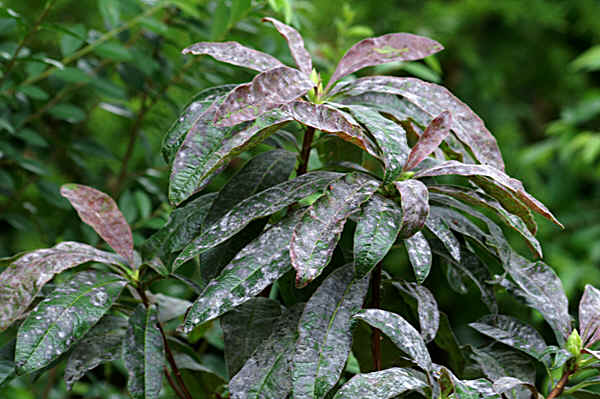 If the azalea
If the azalea
dropped all the leaves
, and its branches are actively drying up, which means that the plant is facing death.
Cause
is covered:
- in violations of the root system;
- after rearrangement;
- in the face of unexpected stress;
-
inappropriate transfers to a new
pot
in conditions of flowering plants.
Pests can also be the culprit. It is necessary to cut off everything dry to those places where there is still living tissue, and then diligently monitor the condition of the bush.
Dry out
or leaves may wrinkle due to insufficient watering or humidity. In this case, the overdried soil underneath it must be quickly saturated with moisture. To do this, it is enough to lower the entire pot with the plant at the base into cool water collected in a container. At the same time, one should not forget that moisture absorbed by overdried soil should not have increased hardness values.In this case, the water should be boiled and cooled, or you should use a settled flowing liquid.
The reason
why does azalea have
yellowing of foliage is observed, there may be chlorosis. This means that the earth is alkalized with calcium. The solution is simple - it is watered with acidified water with a temperature of no more than 15 - 16 degrees Celsius.
Leaves turn black
, more precisely, growing dark red and brown spots appear on them when the plant is infected with septoria. It's a fungus. For him, conditions of high humidity and warmth are best suited. The period of occurrence is spring. The salvation is the treatment with chemicals. Prevention - compliance with the requirements for plant care, as well as prevention of excessive scarcity of representatives of indoor flora.
If the young leaves dry up, and the adults not only turn yellow, but also crumble, and brown spots appear on the surface of both, then the flowering has undergone a disease.
Often, in addition to the previous symptoms, over time, there is a feeling that
leaflets
covered in sticky syrup. The scabbard can suck out the strength of the plant, feeding on its juices. A form of struggle in the midst of the disease for
azalea
- insecticide treatment, at the beginning of the lesion -
«
washing
»
each leaf with soapy water.
 Fall
Fall
leaves can also be due to damage to the plant by a spider mite. A thin cobweb is visible in the internodes of the stems. Leaves change appearance, often curling into tubes, begin
crumble
... The buds dry up. The reason for the appearance of a harmful insect is excessive dryness of the air, as well as a long absence of spraying. Are struggling with the problem that has overtaken
rhododendron
, by spraying the plant with clean water and washing the foliage with soapy water.
Sinking
, as well as curvature of the leaves occurs due to the defeat of the azalea by another problem. Mealyworm deals very strong damage. The insecticide again becomes a rescuer for the bush.
If suffer
leaf tips
, especially young ones, you should look under them. The problem is most likely due to aphids. The pest can be destroyed
«
washing
»
bush with soapy water.
Photo
See a photo of a healthy plant below:
Post navigation
Azalea withered, how to save?
Azalea is very unstable to sudden changes in climate, changes in soil moisture, temperature, composition and fertilizers. The active sun can also serve as a catalyst for her disease, which will lead to the natural drying of the plant. It will begin to shed its leaves, flowers will fall off, and it can be difficult to restore its healthy appearance after such shocks.
Garden azalea is less picky, in contrast to decorative (home) azalea. The latter is renowned for its sensitivity to room temperature rises. Moreover, even a slight jump in the degree can instantly appear on it. How do you prevent azaleas from drying out? First of all, maintain the optimal percentage of humidity in the room, do not place the flower in noticeable proximity to the batteries.
Gardeners often post specific instructions for plant resuscitation. To create it, you need to purchase special tools. Here is a list: ice, sand, cold water, acid (it is better to buy boric or citric acid), pine needles, ash (can be replaced with activated carbon), the drug "Zircon". The scheme of actions is as follows: the azalea must be removed from the pot and placed in a basin of cold water, after taking a bath, rinse the root system under running water. Then he will worry about pruning wilted leaves and removing flowers. Then transplant the flower into a new prepared soil. Add ash or activated carbon, sand to the substrate that you have. Leave the azalea to get used to the new earth overnight.
Reasons: why is indoor rhododendron crumbling?
3 reasons for shedding:
- Violation of the rules of care.
- Diseases.
- Pests.
How to take care at home?
If the rules of care are not followed, the leaves of the azalea fall off.
Watering
It is necessary to water the azalea regularly, in moderation, to exclude waterlogging of the soil. In autumn, when buds are born, watering is reduced. Azalea doesn't like hard water. Watered with settled for at least three days or boiled water. The water is acidified with lemon juice or vinegar: 3-4 drops per 1 liter of water. Water well with distilled water or rainwater. If the watering conditions are not met, the azalea will drop foliage.
The soil
To grow azaleas, the soil must be acidic. It is better to buy it in the store. For azaleas, take a wide pot due to the horizontal location of the root system. If the pot is small, she will shed the leaves.
Transfer
When transplanting, the earthen lump must be left by transferring the azalea to another pot with fresh substrate. Damage to the root system leads to the shedding of leaves.
Azaleas cannot be transplanted during flowering.
Lighting
Azalea likes partial shade or diffused bright light. It should not be placed on a south-facing window sill. Place it on a stand next to the window so that it is illuminated by reflected light. Lack of lighting causes leaves to drop.
Temperature regime
In winter, the air temperature should not exceed + 18 ° С, in summer no more than + 25 ° С. From October to December, when the buds are laid, the temperature is from + 6 ° C to + 10 ° C. In January-February from + 10 ° С to + 15 ° С. In spring during flowering from + 17 ° С to + 20 ° С.
Azalea does not like drafts. It should not be placed on the windowsills of open windows.
Air humidity
The plant prefers air humidity of 70-80%. At lower humidity, regular spraying of the leaves is required. Flowers do not like spraying, stains may appear on them. To maintain air humidity around the blooming azalea, wet peat or expanded clay is placed in the pallet. Dry air and elevated temperatures shorten flowering times and cause flowers and leaves to drop.
Diseases
Fungal diseases of plants:
- Fusarium - causes yellowing of leaves and stems of plants, the appearance of a pale pinkish bloom.
- Verticillosis is a darkening of the base of the plant. The affected plant must be isolated and treatment started immediately.
- Alternaria - brown spots of various shapes are formed.
- Septoria - reddish-yellow spots with a dark center.
- Late blight - root rot, quickly passing to the stem and leaves, causes the death of the plant. It begins with the falling off of the kidneys and the twisting of the leaves.
- Phylosticosis - brown or ash-gray spots with brown contours are formed.
- Cercosorosis - white bloom forms on the top and brownish-red spots on the underside of the leaf.
When it is found that the plant is sick, it showered the buds and flowers, and the leaves turn brown, dry and fall off, or at least one of the above signs, an azalea treatment should be started urgently. It is better to buy drugs in a specialized store, having described in detail the signs of the disease to the consultant.
We offer you to watch a video about common azalea diseases:
Pests
Insects damaging azalea:
- Strawberry mite - damages flowers, buds and upper shoots. Leaves curl around the edges in the form of a boat. The buds do not open or form ugly flowers that quickly die.
- Red mite - damages cuttings and adult plants, Mites live on the underside of leaves, they wither, turn brown and crumble.
- Spider mite - appears at low humidity. A cobweb forms on the stems, the buds dry out. Leaves wither and fall. If detected early, you can get rid of the tick. For this, the plant is washed under a warm shower and wiped with a soapy sponge. In a neglected form, you cannot do without chemicals.
- Greenhouse Whitefly - Sucks out juice. Leaves discolor and fall off.
- Mealybug - affects the azalea. The plant dries up and sheds leaves and flowers.
- Azalea moth - damages leaves. They crumble and crumble. Caterpillars crawl onto healthy foliage, twist it into tubes, continuing to develop inside.
- Greenhouse thrips - eats the leaves, forming holes of light color on top and dark on the bottom, the leaves acquire a silvery hue, turn yellow and fall off.
We offer you to watch a video about pests of azaleas:
Read more about azalea diseases and pests here.
Conclusion
Subject to the rules of care specified in the article, the azalea will delight you with beautiful and noble flowers, a delicate, barely perceptible smell and self-confidence.
Sometimes it happens that our green friends get sick due to inadequate care for them. And Azalea is no exception. From the wrong place or poor watering, the flower can completely shed all its leaves. Let's figure out why this can be so and what to do about it.
In order for a houseplant to bloom and please the eye, it is worthwhile before buying it to familiarize yourself with its habitat and what will be required in the end for its cultivation at home.
Leaves dry and fall
Problems with leaf plates in a plant begin, first of all, if it is not provided with a cool place for maintenance and poor water is used for irrigation. After all, the optimal winter temperature is 15 degrees Celsius, and at the same time Azalea blooms beautifully. When it rises, the flower is able to throw off not only the buds, but all of its leaves.
Knowing these features of Azalea, it is necessary to provide a bright room.
without direct burning rays, where the winter temperature will be in the range of 15-17 degrees Celsius. If there are already drying thin twigs on the stem, they should be cut to living tissue. The next step is transplanting into the acidic soil that is necessary for it and it will be necessary to adjust the watering.
Give Azalea proper care and she will feel good.
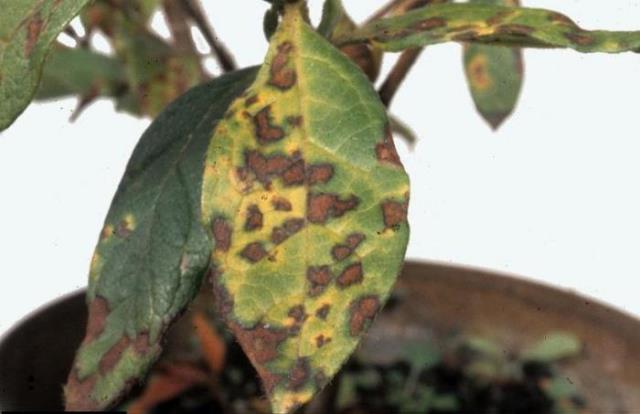 Drying and yellowing of leaves in azaleas
Drying and yellowing of leaves in azaleas
Blackening of leaf blades can have two reasons.
- Black thrips.
- Fusarium.
- Rhododendron mite.
In the first case, it is a small pest.
, which is located on the sheet plates and feeds on plant sap... After which the leaves turn black and die off. To get rid of this pest, you need to treat Azalea with chemicals:
- Actellik;
- Karbaphos.
Inspect your plant weekly and then the thrips will be seen on time and the plant can be cured.
With the second disease, the leaves and trunk of the plant turn black. If almost the entire plant is affected by such blackness, then, alas, it can no longer be saved. But at the beginning of the disease, treatment can be carried out by treating the surface of the trunks with Fundazol.
If this does not help, it is necessary to urgently cut the plant by cutting cuttings from still healthy branches.
When infected with a rhododendron tick (which is easy to detect, since the tick size is almost 4 mm.) Azalea must be urgently treated with Diazinon, if this does not help then, after 10 days, it is treated with Actellik's solution.
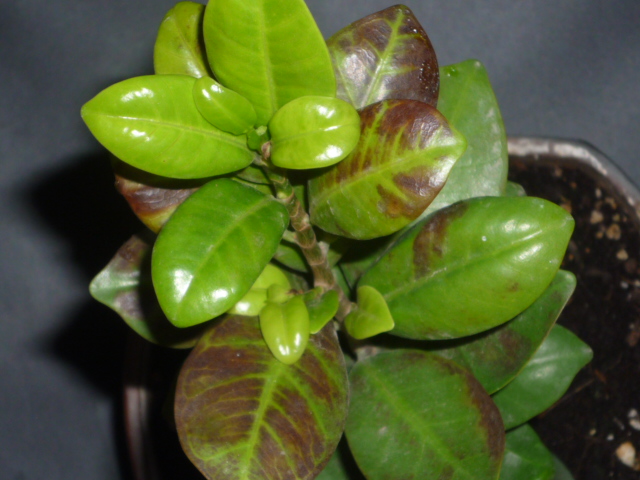
The first and common cause is chlorosis.
... This happens if the flower is overfed with fertilizer with a large amount of calcium. To get rid of this problem, it is necessary to acidify the water used for irrigation and raise its temperature to 16 degrees Celsius.
You can acidify water with acetic acid by adding 3-4 drops of vinegar per liter of water.
Also, leaf plates turn yellow when there is a pest on the plant - a scale insect. To this end, it is necessary to inspect the leaf plates and if small brown spots are found that can be removed with a fingernail, then this is a scabbard. To get rid of it, you need to manually pick off all the pests and spray the Azalea with Actellik's solution. This treatment must be carried out three times with an interval of 7 days.
The place where the flower stood should also be treated with Actellik's solution by wiping the surface.
 The leaves of the flower turn yellow
The leaves of the flower turn yellow
Most likely, the plant is affected by a fungal disease.
or the leaf plates were corny burned by the sun (3).In the first case, we urgently change the land in which Azalea grows, and pour boiling water over the pot for the purpose of disinfection. The flower itself is treated with Fundazole. After all the procedures, we put the flower pot in partial shade and observe whether brown spots on the leaves have stopped appearing. If the flower is burnt by the sun, then we remove the damaged foliage and rearrange the flower away from the sun's rays.
Notice the burn in time, since with a complete burn it will be difficult for the plant to recover.
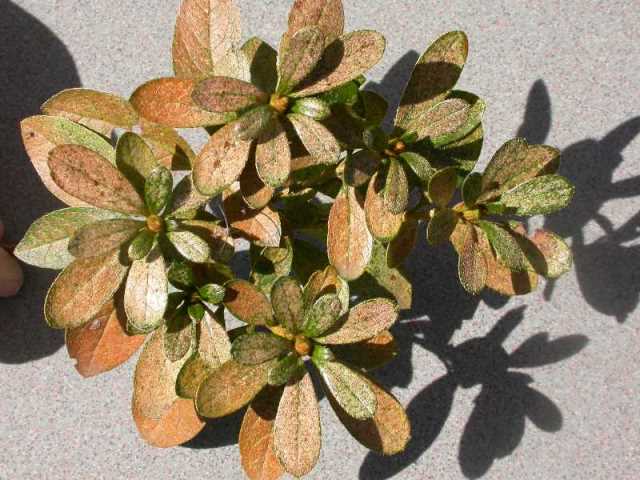 Azalea leaves
Azalea leaves
The buds can dry out from the elevated temperature of the content and at the same time very low humidity (4). To stop drying the buds you need:
- Lower the temperature to 16 degrees Celsius;
- Spray twice a day with warm water from a fine spray;
- Move the pot out of the draft.
By fulfilling all the requirements for this decorative flower, you can achieve its lush flowering.


